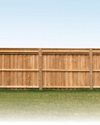Easy enough for a beginner, comfortable enough for a long perch.

A seat like this is usually called a “porch swing,” and a porch certainly is a good location for it. But a hanging seat can go just about anywhere; unlike a chair, it doesn’t require a firm, flat surface beneath it. If you don’t have a suitable ceiling or tree to support a swing, go to familyhandyman.com and search for “arbor” to see other options.
Tools and materials
This swing design is especially forgiving. If your cuts are slightly inaccurate or not quite straight, the swing will still turn out just fine. So, although a table saw, miter saw and band saw are best for this project, you could do it all with only a jigsaw.
The swing shown here is made from cedar, but you could use treated lumber instead. Either material will contain some large knots, which can look bad and create weak spots. Avoid them when cutting parts (Photo 1). The Materials List includes 1 x2s, but if you have a table saw, you'll get better material by ripping 1 x2s from wider boards. Some stores carry cedar that's 7/8 in. thick instead of 3/4 in. If you use 7/8-in. stock, make the stretcher (E) 23-3/4 in. long instead of 24 in.
We chose heavy 5/16-in. yellow zinc-coated chain, but any chain rated for 250 lbs. or more will work. Some stores will cut the chain to length for you. Two Quick Link connectors or S-hooks join the front and back chains to the upper chains-they make adjustments and removing the swing easy.
THINK AHEAD WHEN WORKING WITH CEDAR
Cedar lumber usually has one smooth side and one rough side. So, when you’re making pairs of parts, it’s easy to end up with a mismatch: one part with the smooth side visible, the other with the rough.
Don’t sweat the curves
This story is from the April 2019 edition of Family Handyman.
Start your 7-day Magzter GOLD free trial to access thousands of curated premium stories, and 9,000+ magazines and newspapers.
Already a subscriber ? Sign In
This story is from the April 2019 edition of Family Handyman.
Start your 7-day Magzter GOLD free trial to access thousands of curated premium stories, and 9,000+ magazines and newspapers.
Already a subscriber? Sign In

7 Bicycle Maintenance Tips
Keep your bike in tiptop shape and ride safe!

SETTING FENCE POSTS WITH EXPANDING FOAM
Any fence builder knows you need strong posts for a strong fence, and that means backfilling the postholes with a dense, hard material other than dirt.

PEBBLE MOSAIC STEPPING STONES
COLLECT SOME RIVER ROCK AND MAKE YOUR OWN UNIQUE STEPPINGSTONE PATH

EARTH-FRIENDLY WEED KILLERS
HEALTHIER CHOICES FOR HUMANS AND THE ENVIRONMENT

DIY! HYDROPONIC GARDEN
FRESH VEGETABLES AT YOUR FINGERTIPS

GROW MINI VEGETABLES
GROW A GARDEN IN A TINY SPACE!

BUILD A VERTICAL GARDEN
TIME TO GROW UP!

MODERN WATER FOUNTAINS
A SPLASH OF PEACE FOR YOUR PATIO

9 ALTERNATIVE USES FOR SAWDUST
Every fully stocked wood shop has a table saw. You can usually find a pile of sawdust under it, even if it's used only occasionally. If a shop has a belt sander or band saw, there's probably another pile of finer sawdust under that. Even people without stationary tools have sawdust accumulation on their workbenches.

INSULATE WITH FOAM
IT'S A GREAT ALTERNATIVE TO FIBERGLASS